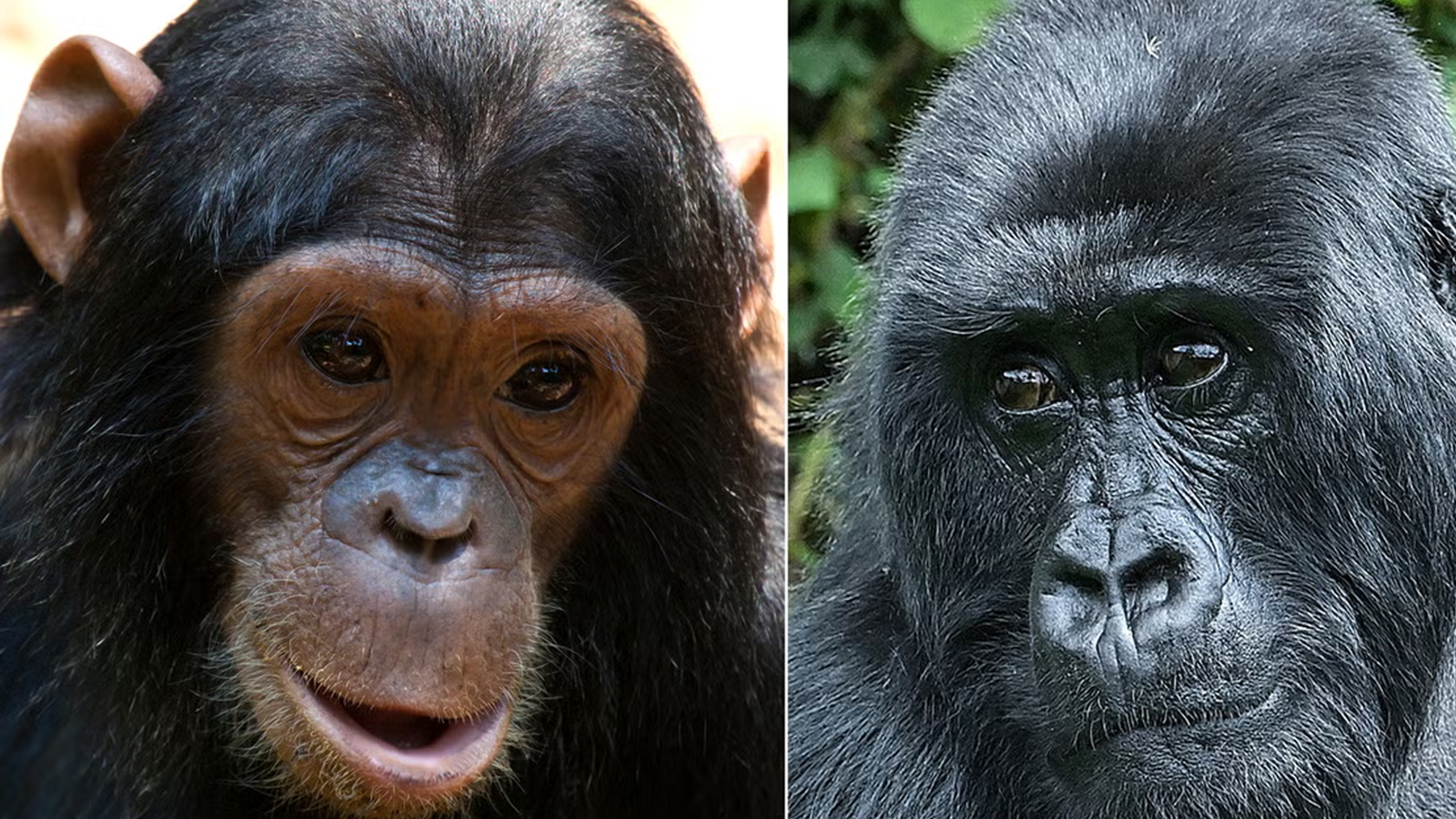Wildlife in Bwindi National Park
Bwindi Impenetrable National Park is one of Uganda’s most famous wildlife place, known particularly for its population of endangered mountain gorillas. The park is located in southwestern Uganda and covers an area of about 321 square kilometers. Bwindi is a UNESCO World Heritage Site and a vital conservation area for protecting the highly endangered mountain gorillas.
Chimpanzees:
Chimpanzees are one of the closest living relatives to humans and belong to the genus Pan. They are part of the Great Ape family, along with bonobos, gorillas, and orangutans. Chimpanzees are highly intelligent and social animals, and they share approximately 98% of their DNA with humans. Here are some key characteristics and facts about chimpanzees:- Habitat: Chimpanzees are native to the forests and woodlands of central and West Africa, including countries such as Uganda, Tanzania, Rwanda, Democratic Republic of Congo, and others.
- Physical Characteristics: They have a robust build, long arms, and no tail. Their bodies are covered in black hair, with lighter skin on their faces, hands, and feet.
- Social Structure: Chimpanzees live in complex social groups called communities. Each community typically consists of several individuals, led by a dominant male called the alpha male. The social structure also includes females and their offspring.
- Tool Use: Chimpanzees are known for their impressive ability to use tools. They use sticks, leaves, and stones as tools to extract insects from nests or to crack open nuts.
- Communication: Chimpanzees communicate using a combination of vocalizations, facial expressions, and body postures. They can convey a wide range of emotions and intentions through these means.
- Diet: Chimpanzees are omnivores, which means they eat both plant and animal-based foods. Their diet includes fruits, leaves, flowers, insects, and occasionally small mammals.
- Endangered Status: Chimpanzees are listed as endangered by the International Union for Conservation of Nature (IUCN). Their populations have been declining due to habitat loss, poaching, and disease.
- Research Importance: Chimpanzees have been studied extensively for their cognitive abilities, social behaviour, and use of tools. They have provided valuable insights into human evolution and behaviour.
Other primates:
Other than chimpanzees, there are several other primate species found in various parts of the world. Primates are an order of mammals that include a wide range of animals, from lemurs and monkeys to apes and humans. Here are some examples of other primates:- Gorillas: Gorillas are the largest living primates and are closely related to humans. They are found in the forests of central Africa and are divided into two species – the Eastern Gorilla and the Western Gorilla.
- Orangutans: Orangutans are native to the rainforests of Borneo and Sumatra in Southeast Asia. They are known for their distinctive reddish-brown fur and are the only great apes found in Asia.
- Bonobos: Bonobos are also known as pygmy chimpanzees and are closely related to chimpanzees. They are found in the dense forests of the Democratic Republic of Congo in Central Africa.
- Lemurs: Lemurs are native to Madagascar and are characterized by their unique adaptations and diversity. There are many species of lemurs, ranging from the tiny mouse lemurs to the large indri lemurs.
- Monkeys: There are various species of monkeys found in different parts of the world. Some examples include the capuchin monkeys of Central and South America, the colobus monkeys of Africa, and the langurs and macaques of Asia.
- Gibbons: Gibbons are small apes found in the forests of Southeast Asia. They are known for their acrobatic abilities and distinctive calls.
- Tarsiers: Tarsiers are small, nocturnal primates found in Southeast Asia. They have large eyes and are skilled jumpers and climbers.
- Mandrills: Mandrills are large and colourful monkey’s native to the rainforests of Central and West Africa. They are known for their striking facial markings.
- Spider Monkeys: Spider monkeys are arboreal primates found in the forests of Central and South America. They have long limbs and a prehensile tail, which they use to swing through the trees.
Birds:
Birds are a diverse group of warm-blooded vertebrates belonging to the class Aves. They are characterized by their feathers, beaks, and the ability to lay eggs. Birds are found all over the world, in a wide range of habitats, from oceans and forests to deserts and grasslands. Here are some key characteristics and facts about birds:- Feathers: Feathers are one of the defining features of birds. They provide insulation, aid in flight, and play a crucial role in courtship displays and communication.
- Beaks: Birds have beaks or bills that are adapted to their specific diets and lifestyles. Beak shapes can vary widely, from the strong and hooked beaks of birds of prey to the long, slender beaks of hummingbirds.
- Flight: While not all birds can fly, flight is a significant characteristic of many species. Birds have lightweight, hollow bones and powerful muscles that enable them to take to the air.
- Endothermy: Birds are endothermic, meaning they can regulate their body temperature internally. This ability allows them to maintain a relatively constant body temperature, even in changing environmental conditions.
- Reproduction: Birds lay eggs, which they incubate to hatch their young. They exhibit a diverse range of breeding behaviors, from monogamous pairs to complex mating displays in lekking species.
- Migration: Many bird species undertake long-distance migrations to find suitable breeding and feeding grounds. These migrations are often impressive feats of endurance and navigation.
- Vocalizations: Birds use vocalizations to communicate with each other, establish territories, and attract mates. Birdsong can be highly complex and melodious.
- Diversity: Birds are incredibly diverse, with over 10,000 recognized species. They vary greatly in size, shape, color, behavior, and habitat preferences.
- Conservation: Many bird species are facing threats such as habitat loss, climate change, and pollution. Numerous conservation efforts are underway to protect endangered bird populations and their habitats.
- Falcons and Hawks (Falconidae): Known for their impressive hunting skills and sharp talons.
- Owls (Strigidae): Nocturnal birds of prey with exceptional night vision and silent flight.
- Hummingbirds (Trochilidae): Small, colorful birds capable of hovering in mid-air due to their rapid wing movements.
- Parrots (Psittacidae): Known for their intelligence, vibrant plumage, and ability to mimic sounds.
- Penguins (Spheniscidae): Aquatic, flightless birds adapted for swimming and diving.
Forest elephants:
Forest elephants (Loxodonta cyclotis) are one of the two recognized species of elephants, with the other being the more well-known African savanna elephants (Loxodonta Africana). Forest elephants are a distinct subspecies of the African elephant and are primarily found in the dense, tropical rainforests of Central and West Africa. Here are some key characteristics and facts about forest elephants:- Size: Forest elephants are smaller than savanna elephants, with males typically standing around 8 to 9 feet (2.5 to 2.7 meters) tall at the shoulder. They have slender and straighter tusks compared to their savanna counterparts.
- Habitat: As their name suggests, forest elephants inhabit dense forests, including tropical rainforests, swamp forests, and lowland forests. They have adapted to life in these challenging environments.
- Behaviour: Forest elephants are known for their more elusive and secretive nature compared to savanna elephants. They are less social and tend to live in smaller, family-based groups.
- Diet: Forest elephants primarily feed on a variety of fruits, leaves, and vegetation found in the forest undergrowth. They are essential seed dispersers for many tree species, contributing to the forest’s ecological balance.
- Conservation Status: Forest elephants are listed as Vulnerable by the International Union for Conservation of Nature (IUCN). They face significant threats from habitat loss due to deforestation, as well as poaching for their ivory tusks. The remote and dense nature of their habitat also makes it challenging to monitor and protect their populations effectively.
- Genetic Differences: Recent genetic studies have confirmed that forest elephants are a genetically distinct subspecies from savanna elephants. The two types of elephants have been isolated from each other for millions of years, leading to differences in their physical traits and behavior.
- Communication: Like all elephants, forest elephants use various vocalizations, body language, and seismic communication to communicate with each other, even in the dense forest environment.


